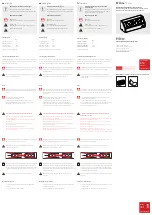
RAWS-P Remote Automated Weather Station
9. References
9.1 Specifications, Equipment and Sensor
Specifications are available from our web site at
http://www.campbellsci.com/index.cfm.
For “sensors specifications,” click on “Products”, select “Sensors” and go to
the sensor manual for specifications. For “equipment specifications”, enter the
part # in the “Search” box on the website mentioned above and go to the
equipment manual for specifications.
Equipment and sensor specifications are provided on the
Resource CD which ships with the RAWS
NOTE
9.2 Siting References
General guidelines for site selection are listed below.
EPA, (1987):
On-Site Meteorological Program Guidance for Regulatory
Modeling Applications
, EPA-450/4-87-013, Office of Air Quality
Planning and Standards, Research Triangle Park, NC, 27711.
WMO, (1983):
Guide to Meteorological Instruments and Methods of
Observation
, World Meteorological Organization, No. 8, 5th edition,
Geneva, Switzerland.
The State Climatologist, (1985):
Publication of the American Association of
State Climatologists: Height and Exposure Standards, for Sensors on
Automated Weather Stations
, vol. 9, No. 4.
EPA, (1989):
Quality Assurance Handbook for Air Pollution Measurement
Systems
, EPA Office of Research and Development, Research Triangle
Park, North Carolina 27711.
9.3 RAWS Orientation
9.3.1 Determining True North and Sensor Orientation
Orientation of the wind direction sensor is done after the datalogger has been
programmed and the location of True North has been determined. True North
is usually found by reading a magnetic compass and applying the site-specific
correction for magnetic declination; where the magnetic declination is the
number of degrees between True North and Magnetic North. Magnetic
declination for a specific site can be obtained from a USGS map, local airport,
or through the web calculator offered by the USGS (Section 9.3.2). A general
map showing magnetic declination for the contiguous United States is shown
in Figure 9.3-1.
Declination angles are always subtracted from the compass reading to find
True North. A declination angle East of True North is reported as positive a
value and is subtracted from 360 (0) degrees to find True North as shown
Figure 9.3-2. A declination angle West of True North is reported as a negative
value and is also subtracted from 0 (360) degrees to find True North as shown
22
Summary of Contents for RAWS-P
Page 6: ...RAWS P Table of Contents iv...
Page 32: ...RAWS P Remote Automated Weather Station 26...
Page 33: ......






































